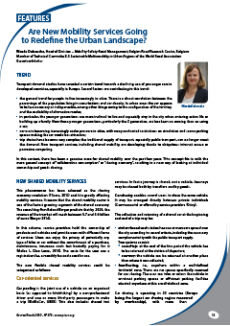Publications Routes/Roads Urban Mobility
This page lists Routes/Roads articles of PIARC in the field of urban mobility. These publications are classified chronologically.
-
Best Practices for improving urban transport efficiency in China: Case study in Zhuzhou and Shenzhen

The urbanization of China continues to intensify, as 57% of the population currently lives in cities [1]. The growth occurring in urban areas has resulted in significant increases in traffic congestion and air pollution and moreover has highlighted the need for improvements in urban transport management.
-
Enhancing the Benefits Ascribed to «Bus Rapid Transit» Projects

Bus Rapid Transit (BRT) is a transportation system built around bus routes in the aim of providing an efficient and high-quality service similar to that inherent in rail modes, by taking advantage of the flexibility, speed of execution and reduced costs associated with road transportation modes. BRT thus contributes to cities’ transportation supply a pragmatic and affordable component that adapts to the pace of urban growth.
-
The Case for Optimizing the Use of Public Urban Spaces

In 2011, the world’s population topped seven billion, with half this number residing in cities. According to the United Nations, this trend will intensify, as five billion urban dwellers are projected in year 2030, accounting for 60% of the planet’s inhabitants and 80% of the population across the developing world. This expanding number of urban residents raises many questions in light of today’s existing models, which in most instances have adverse effects on the environment (urban sprawl [...]
-
Sustainable Mobility in Urban Regions: What are the Highest-Priority Needs?

Cities and their outskirts accommodate high concentrations of transportation flows, in terms of passengers and freight, which remain quite distinct in both their scope and frequency: major transit flows, intercity exchanges, daily mobility patterns. This article will primarily focus on day-to-day mobility concerns in France, but the first step of such an analysis entails specifying the investigation boundary: how far does the city exert its influence over daily transportation habits?
-
Are New Mobility Services Going to Redefine the Urban Landscape?

Transport demand studies have revealed a certain trend towards a declining use of passenger cars in developed countries, especially in Europe. Several factors are contributing to this trend: the general trend for people to live increasingly in cities. There is a direct correlation between the percentage of the population living in conurbations and car density. In urban areas the car appears to be less necessary or indispensable, among other things owing to the configuration of the territory and [...]